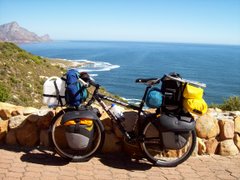





Three weeks of cycling through Bangladesh has been an interesting experience. This is the most densely populated country on earth, with about 160 million people packed into a relatively small space. I was literally never alone - wherever I looked I could see people, and when I stopped a large crowd would immediately gather around to stare. Very little English is spoken, and road signs as well as writing on buildings etc. is mostly in Bangla (different alphabet). However, I found the people to be extremely friendly and welcoming, often buying me tea at the roadside stalls and thanking me for visiting their country. There are very few tourists, and in these 3 weeks I only spotted a handful of foreigners. In the cities and towns the main form of transport is the cycle riksha, often clogging the narrow streets and bringing traffic to a stand-still. In the capital Dhaka, a city of 15 million, there are apparently more than 600 000 of these riksha's. Flat-bed "cargo riksha's" as well as bicycles are also prevalent. Bangladesh is a beautiful green country with water everywhere (reportedly more water flows through this country than through the whole of Europe). Many of the rivers are navigable, and boats of all shapes and sizes are used to ferry passengers and a variety of cargo. On a few occasions I had to take a ferry ride across wide rivers where there are no bridges. In other places I crossed bridges a few k's long. I also visited the 2nd largest city (Chittagong), where the ship-breaking yards on the beaches North of the city can be seen from the road (I was not permitted to take photo's or even enter the yards). I also went further South-East (almost as far as the road goes) to swim at the beach of the "holiday city" Cox's Bazar. In Comilla I was interviewed by the editor of the local newpaper, Bakin Rabbi. He and his wife (Shahan) invited me to stay for the night, and they fed me so well that I must have made a big dent in their food budget. The most dangerous thing I found in Bangladesh is the continuous stream of busses on the main roads. The bus drivers obviously have visions of Grand Prix racing as they charge flat-out through villages along the crowded narrow roads (I did see quite a number of accidents). I suppose the next most dangerous thing was at Cox's Bazar, where I woke during the night to find a cat burglar on the ledge outside my 3rd floor window fishing for valuables through the burglar bars with a bamboo pole (he managed to escape with 2 banana's). I've now returned to India, and am back in Kolkata with a brand-new visa. All I need now is money, as my stash has just about run out. Daily distances cycled since my last report are:- Bangoan 81 km; Jessore 48 km; Faridpur 98 km; Manikganj 68 km; Dhaka 68 km; Comilla 95 km; Chittagong 163 km; Cox's Bazar 172 km; Chittagong 152 km; Feni 98 km; Comilla 60 km; Dhaka 97 km; Faridpur 128 km; Jessore 98 km; Kolkata 127 km. Total distance since the start of this jouney is 30 605 km.













